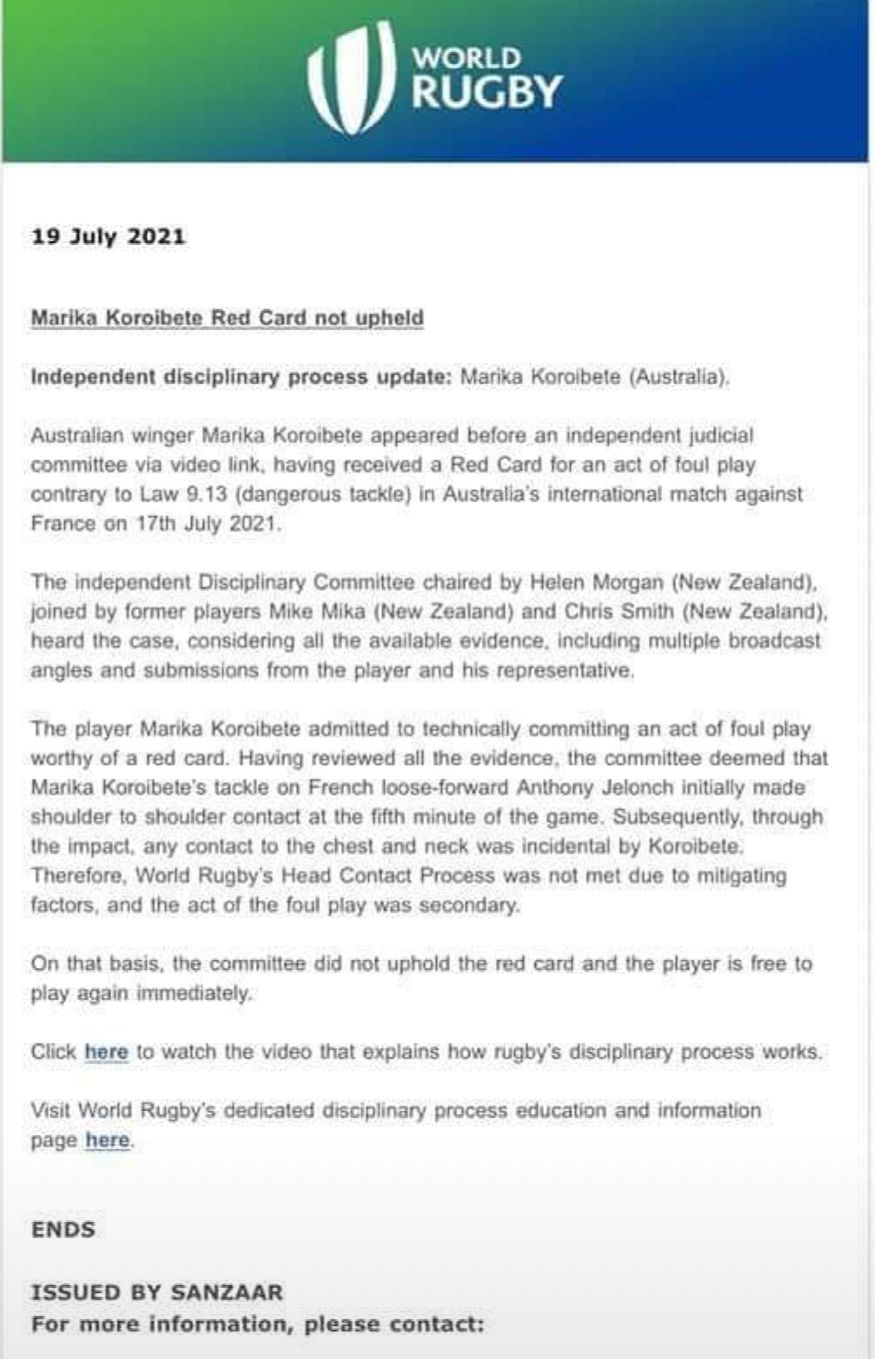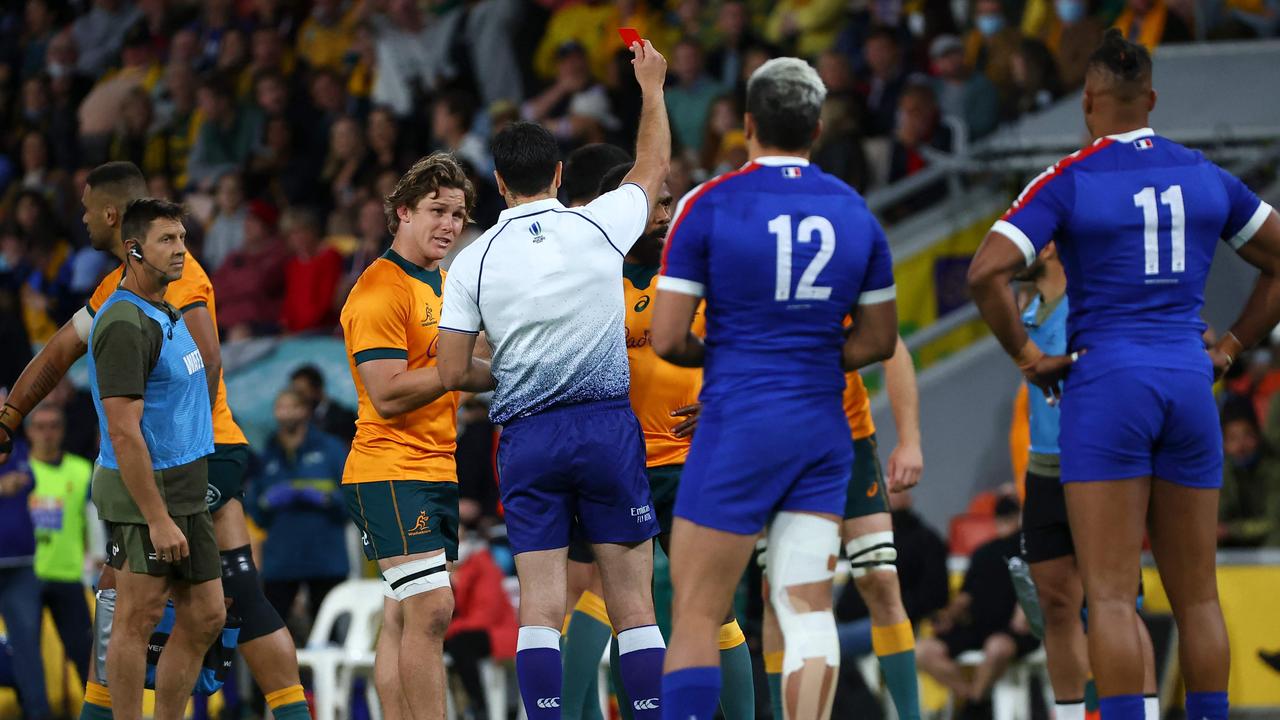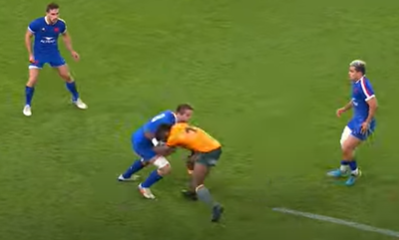Wallabies v France 3
-
I wonder if "chest and neck" in that statement was an error, and it should have said "head and neck"?
Still wildly confusing. They really need to clarify how they worked through the process, what the correct outcome should have been, an what evidence they used to get there. Right now we're not sure if that kind of tackle is perfectly legal, or a yellow card offence.
-
There is a delay of a few days between the decision and the media releases being sent to media, and the decision being published on World Rugby's website. It will be there in the next few days.
@gibbonrib said in Wallabies v France 3:
@bones
I'm also confused.
Any head contact was "incidental"? What's that mean? It was negligible / irrelevant from a disciplinary point of view? Or a player safety point of view?[Edit: just realised that the quote above says "any chest / neck contact was incidental". Which frankly makes even less sense. ]
Also curious about how they reached that conclusion. None of the replays on the night were conclusive.
Maybe a good lawyer trumps clear video evidence.
That's because the TMO, citing commissioner, judiciary and the lawyers have access to many more camera angles than are shown on tv. The difference between the TMO and the rest is time to have a close look at all the footage, so that's where some of the differences in outcome already come from. Obviously, it's possible that camera angles are not 100% clear, and then having a good lawyer will definitely make a big difference.
-
And here you go, right on cue it's Fox Sport putting outrage ahead of reality:
"Wallabies winger Marika Koroibete is free to play in Bledisloe I after he was cleared of any wrongdoing"
Except he wasn't. We need to wait for the full ruling to be sure, but it seems they decided he committed a foul worthy of a yellow card.
Unfortunately most people reading this won't have the necesary bullshit detection skills, and will come away thinking the ref was drunk.
-

-
@steven-harris where did you find that?
Sadly that statement doesn't clarify the decision at all. I'd like to watch that video to see if that helps (fully expecting that it won't though).
-
@gibbonrib said in Wallabies v France 3:
@nevorian I don't think it was ever considered malicious, reckless is enough for a red if there's no mitigation
Exactly, most of the high tackles are reckless not malicious. They keep going on about the tackler having to be responsible for any head contact, even if it slips up.
The only way I can see this being a yellow, as there was forceful head contact, is if they say the French 8 dipped enough for there to be mitigation. But they are seem to be saying that contact slipping up is only a yellow, and that's not how it's been ruled in the past.
So fucking inconsistent all this bullshit. No wonder coaches and players have no idea whats going on from one game to the next.
-
@kirwan Yup, rules that are inconsistently applied on the field, then inconsistently confirmed / overturned by the review committee, which then sends out muddled and misleading communications on the outcome, with the whole process being commentated on by a bunch of former players who either don't understand the framework or don't care if they're talking nonsense.
There's certainly a little room for improvement.
-
-
@derpus
You can't tell much from a still, certainly not how much he dipped into it. Seeing it live, I thought he did dip into it a little, but that it was a natural instinctive movement to brace for the impact, not really a mitigation.
In real time, I thought it was a great tackle. But after seeing the replays which showed clear head contact. I was expecting yellow, on the basis that it looked like it wasn't direct to head, and the fact that it was the 4th minute (which shouldn't affect the decision, but was hard to ignore) -
@derpus said in Wallabies v France 3:
Someone posted this shot earlier. You'd think the easy option is to just say it was a red card but mitigated due to body height. MK is basically horizontal to the ground at the point of contact and Jelonch clearly drops into it.
This is where screenshots don't help. He wasn't horizontal, more on a 45 degree angle up. And watching the replay you can see the French 8 lifted off his feet because of it.
But if you take one angle, like this, it looks different.
And here we are arguing about it days later, and the ref had what, 1 or 2 mins to make the call watching the big screen? Refs are in an impossible situation with this new focus on head highs.
-
@nta said in Wallabies v France 3:
I prefer the side angle wide shot where you can see both guys start upright and then both lower into contact.
The question is: how low should the ball carrier be? This isn't him running into contact, it is bracing for impact.
I think he has a reasonable dip there, so it should have been yellow. Not sure what a "reasonable" dip is for the mitigation dance.
-
The other thing i don't really understand about the protocol is why wasn't Valetini yellow or even red carded later in the game when he clocked the guy directly in the head? The protocol doesn't seem to say that shoulder contact is worse than forearm.
The player was exactly where you would expect him to be making that run so i don't see how you could argue body height as mitigation (which seems to be the interpretation above).
-
@kirwan said in Wallabies v France 3:
And here we are arguing about it days later, and the ref had what, 1 or 2 mins to make the call watching the big screen? Refs are in an impossible situation with this new focus on head highs.
This is a great point, but it highlights the error I think BOK and his team made: with each angle showing something slightly different (especially in regards to first point of contact), why did they not acknowledge the presence of doubt and opt for a YC?
It's still the key question days afterwards, and the judiciary mess only serves to reinforce it I think.

